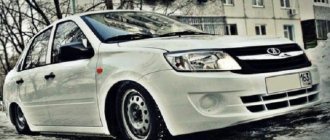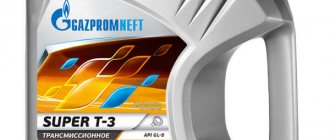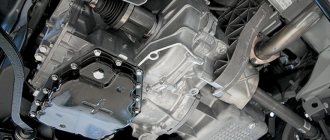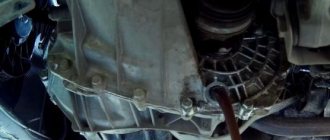In the fall, AVTOVAZ presented the updated Lada Vesta. Now this family is equipped with a Renault-Nissan alliance engine (1.6 l, 113 hp) and a continuously variable automatic transmission JF015E (hereinafter referred to as “variator” or CVT). We managed to find out how the car turned out during the test drive.
Manual transmissions
Until September 2021 The Lada Vesta was equipped with manual gearboxes manufactured by Renault, which, in order to optimize and reduce the cost, were replaced with Russian-made gearboxes. The new gearboxes, marked with the VAZ-21807 index, have become a reinforced version of the traditional base VAZ-2180 gearbox, equipped with a cable drive shift mechanism. Modification 21807 is designed for higher torque than 2180 and is much quieter than the original box.
With the change of box, the gear ratio of the main pair was slightly increased from 3.87 to 3.94. Vesta has also become more dynamic according to the passport: the acceleration time to 100 km/h has decreased from 11.2 s to 10.2 s and the maximum speed has increased from 175 km/h to 188 km/h. Although, as a minus, it can be noted that fuel consumption has increased slightly: from 6.9 to 7.5 l/100 km in the combined cycle.
Related Posts
Lada Granta FL standard radio and installation of the upgraded version
Which spark plugs are suitable for replacement in Lada X Ray?
How Vesta drives with a CVT
During the test drive of the Lada Vesta with a CVT, the following features
:
- There is a creeping mode (in “D” mode, the car itself begins to move smoothly when the brake pedal is released).
- During acceleration, there is an imitation of gear shifting (during normal driving, shifting occurs at 3500 - 4000 rpm, at full throttle - after 5000 rpm).
- There is no monotonous howl of the engine during acceleration, which many owners of cars with a CVT do not like.
- “Shifting gears” occurs without the slightest jerk.
- In manual shift mode "M" there are 6 virtual gears.
- In manual mode, the virtual gear is automatically reset to 1st when stopped.
- In manual mode, the virtual gear will automatically shift at 5500 rpm (500-800 rpm higher than in "D" mode).
- Acceleration of the Lada Vesta SW Cross to 100 km/h with one passenger and a full trunk takes 16 seconds, without a passenger - 13.4 seconds (according to the passport 12.2 seconds).
- Acceleration of the Lada Vesta Cross sedan to 100 km/h was 12.7 seconds in one direction, 13.7 in the opposite direction (11.3 seconds according to the passport).
- Fuel consumption during fairly active mountain tests did not exceed 10.3 l/100km.
- The CVT settings keep the engine speed low, which allows the engine to be quieter than other transmissions (at 120 km/h your tachometer will read 2000 rpm).
- With a sharp start, a slight delay is felt before the start of movement.
- The engine braking capabilities of the car are very limited; there is no noticeable deceleration.
- Due to the appearance of new universal joints of the same length, now during acceleration, especially on poor surfaces, the steering wheel no longer breaks out of your hands, and there is more stability during emergency braking.
- Off the asphalt, the car feels very insecure (the car has difficulty crawling even on a grassy slope with a soft top layer, not to mention driving on a liquefied primer or slippery gravel).
- It is better to overcome steep climbs by walking. If you stop on such a hill, the variator sometimes rebels - when starting from a standstill, it releases the clutch and refuses to go further.
- The overtaking margin at speeds above 120 km/h is not enough, especially on mountain roads. On the plains the situation is better, but not globally. Even in manual mode it feels like you're driving in ECO mode.
In general, everything is simple, clear and practical. For the city, Vesta with a CVT is enough, but outside the asphalt the car feels very insecure. Have you ever driven a Lada Vesta with a CVT? What feedback and impressions can you leave?
Some features were taken from test drive data from wheels.ru and artemspec.
Automatic boxes
The first automated gearbox, VAZ’s own AMT design, appeared in the fall of 2014. It is designed on the basis of a 5-speed manual gearbox and complemented by an electronic control unit and ZF actuators.
In February 2021 New AMT 2.0 robots also appeared, replacing the first AMT development. The AMT 2.0 robotic gearbox is installed only on 1.8 engines, however, it is possible to reflash cars of previous releases, including those with a 1.6 engine. To do this, you need to contact the dealership. To activate the Crawl mode on earlier cars, it is necessary to reflash the engine ECM and AMT. No structural changes are required to the car.
What kind of robot is on the Lada Vesta
The Vesta robot was created on the basis of a VAZ 21827 manual transmission, to which a control unit, actuators and drives from the German company ZF were added. AMT transmission sensors are connected to the Lada's on-board computer. The most useful feature in Vesta is the indicator with gear shift prompts. The hint of Lada Vesta is two triangles pointing up and down. When one of them lights up, it means you should engage an upshift or downshift. This option is accompanied by sound, which can be disabled.
AMT automatically releases the clutch electronically. To start moving, you need to remove the lever from the neutral position and press the accelerator pedal. To bring the Vesta robot as close as possible to the machine, there is. The chipped Lada begins to move when the brake pedal is released.
Disadvantages of the robot
The robotic transmission has been discontinued overseas due to a number of problems. They are also present on the Lada Vesta AMT.
Gear shifts abruptly, jerks in movement are possible; The semi-automatic machine “thinks” for a long time; during dynamic driving, it does not put the required pair of gears into operation at the right time; On an ascent, it downshifts belatedly.
The disadvantages are less noticeable if you drive smoothly and do not brake or accelerate sharply.
Advantages of the robot
Why did AvtoVAZ decide to produce Vesta with this type of box? The fact is that:
The robotic gearbox of the Lada Vesta is cheaper to construct than a classic automatic; Vesta with a robot uses fuel more economically, unlike other gearboxes; A special feature of AMT in comparison with automatic transmission is almost three times less transmission oil consumption; The electronic mechanism provides protection against engaging the wrong gear while driving (this happens on mechanics); The robot rarely breaks down and does not need to be frequently diagnosed and maintained; The clutch engages and disengages smoothly when starting off and changing gears, the lever does not vibrate while driving; Manual transmission is less noisy than manual transmission; Inside the box there is an option to compensate for clutch wear - it further extends the service life of transmission elements; The box is used in automatic or manual mode, whichever is more convenient.
Variable speed drive
And, of course, fans of the Togliatti auto industry are looking forward to the appearance of the promised CVT in 2021. According to preliminary information, a variator with an imitation of 7 steps will first be offered in combination with the Nissan 1.6L HR16 engine, since we are talking about the Jatco JF015E transmission, which is designed for torque up to 160 Nm. It is quite possible that in the future the CVT continuously variable transmission will be gradually adapted to its own 1.8L engine.
The advantages of a CVT over an AMT are obvious. This is, first of all, the convenience of speed control. Cars with CVT pick up speed especially smoothly, without jerks or dips. They have a smoother ride and more dynamic acceleration than AT cars. The CVT is significantly quieter and more economical than classic torque converter transmissions.
About the variator
According to this site, the upgraded JF015E variator replaced the JF011E. The constructive idea is fundamentally different from its predecessor. The JF015E also has a torque converter that softens the load on the shafts, a planetary gear for reverse, but the main feature is two forward stages and three clutch packages: Direct No. 1 (Low), - No. 2 (High) and Reverse. This design made it possible to reduce the cone, increasing the gear ratio to a record 1:7.3 using two forward gears. Thus, this Jatco transmission can be called a two-speed CVT.
Another expat
An imported engine is paired with a CVT. For Nissan it is indexed HR16, for Renault it is H4M. 113 forces were removed from the working volume of 1.6 liters. Production, up to the casting of the head and block, is established in Togliatti.
AVTOVAZ officially allows the engine to be fed with AI-92 gasoline, although it is unlikely to be happy with such food. For example, not every “ninety-second” likes the editorial Vesta with the VAZ 1.6. But the dealer will no longer be able to refute the customer with a warranty claim if AI-92 was poured into the tank.
Gear ratio AMT Lada Vesta SV Cross
However, it is not entirely fair to consider the robot installed on Grant, Kalina and Priora to be similar to Vesta’s robot. The fact is that in the new model, AvtoVAZ engineers have significantly improved the settings of the gearbox itself. Yes, there are no fundamental changes, but there are still minor differences. For example, the difference in gear ratio. On AMT SV Cross it is 3.9, for others it is 3.7.
During practical tests, it was found that when the speed reached 120 km/h, Vesta’s tachometer showed 3200 rpm, while on “old” models the same indicator froze at around 3000 rpm.
Motor specifications
| Factory index | HR16DE/H4M K-1 |
| Start of production | 2006-present |
| Cylinder block | aluminum, in-line cylinder arrangement |
| Supply system | injector |
| Number of cylinders | 4 |
| Valves | 16 |
| Piston stroke | 83.6 mm |
| Cylinder diameter | 78 mm |
| Compression ratio | 9.5 |
| Engine capacity, cc | 1600 |
| Engine power, hp/rpm | 110/6000 (specifically on the VAZ version) |
| Torque, Nm/rpm | 150/4400 |
| Fuel | 92-95 |
| Emission standards | Euro 5 |
| Fuel consumption, l/100 km - city - highway - mixed. | this indicator is still unknown, because The installation of this motor has yet to begin. but from experience in other cars with this engine, we can say that it eats within the limits acceptable for the budget segment. What is the fuel consumption on Vesta? |
| Oil consumption, g/1000 km | up to 500 |
| Engine oil | 0W-20 5W-30 |
| How much oil is in the engine | 4.6 |
| When replacing, pour, l | 4.3 |
| Oil change carried out, km | 15000 (preferably every 10 thousand km.) |
Among the features of the motor I would like to note:
- timing chain drive (no more breaking belts)
- lack of hydraulic compensators (you will have to adjust the valves every 80 thousand km)
- Inlet phase shifter
- The engine resource is about 250 thousand km.
- 2 injectors per cylinder are installed
Available configurations
If you go to the official website lada.ru, you will see that the most affordable configuration of the Vesta SV Cross, on which you can install a robotic box, is Luxe with the assigned code GFK32-52-X00. Its cost is 845,900 rubles. A machine of this configuration is equipped with almost everything necessary, is very comfortable and safe.
The next model configuration is called Luxe Multimedia with code GFK32-52-XK2. The price tag for it is higher than the previous one and equals 873,900 rubles. As is clear from the name of the configuration, the difference between it lies in multimedia. The more expensive trim level is equipped with a navigation system and six speakers, while the poorer trim level has “only” four speakers.
The last, most expensive trim level is Luxe Prestige. Code designation GFK32-52-XSH. It differs from the “multimedia” version in the presence of a rear armrest, tinted rear windows, a power outlet in the rear and heated rear seats. For the “fattest” configuration you have to pay 891,900 rubles.
To confirm our words about the cost of a robotic box, we offer you a few simple steps. Pay attention to the Luxe Multimedia package, but with a manual transmission.
Read also: Lubricant for Bosch Superfit calipers
As you can see in the picture, the cost of a model with this equipment is 823,900, which is exactly 25,000 cheaper than with AMT. Simple math in action.
Alternative, what to choose for this money?
Agree, it’s difficult to realize that the cost of a domestic car can be more than 800,000 rubles. Probably every car owner will think several times about what new cars he can buy for this amount, besides Vesta. It is noteworthy that SW Cross simply has no competitors in this segment; many will choose between Vesta SV Cross and Solaris, Rio, Polo sedan and Rapid. Of all the above, we would give preference to Rapid, because The trunk of a Czech car is more spacious, and there is the option of choosing an automatic transmission. Not many journalists mention that for the amount of 890,000 rubles you can buy a Renault Duster crossover with a 2.0 liter gasoline engine and all-wheel drive. Yes, of course, the Duster will be more expensive, but you will get all-wheel drive.
Another alternative is to consider purchasing the Chinese crossover Chery Tiggo 2
This model, in our opinion, also has a very attractive interior and exterior design; moreover, the technical parameters of the Chinese crossover and the domestic station wagon are similar. Both cars have plastic body protection, high ground clearance and front-wheel drive. Chery Tiggo 2 is equipped with a 1.5 liter petrol engine producing 106 hp. The price of a car in Russia, depending on the configuration, varies between 598,000 – 789,900 rubles.
Read also: Crash tests of child car seats table
This list may also include a huge list of Chinese crossovers whose price will be comparable to the all-terrain version of the station wagon.
I don’t like Chinese cars, ok, as an alternative you can consider the Korean crossover Hyundai Creta
Yes, of course, it will be a car with a basic configuration and front-wheel drive, but you will receive a 5-year warranty, a 1.6 liter gasoline engine and a 6-speed manual transmission, a high seating position, an attractive design and, most importantly, reliability.











